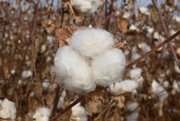Are You Getting Enough Fiber?
Louis Vuitton handbags aren’t the only fashion items prone to counterfeiting.
And while the disparity may be less obvious and the motives less onerous, the labels on luxury Pima cotton products don’t always tell the truth, according to Buxton Midyette, vice president of marketing and promotions for Supima, the organization that represents American growers of extra-long-staple American cotton.
“Supima has always made it a priority to focus on certification of our licenses,” explains Midyette, “so any product bearing the Supima name needs to be authenticated. Up until now we’ve achieved that through a paper trail of documentation.”
That will soon change thanks to new DNA-based technology that can take a finished apparel garment and determine exactly what kind of cotton was used, and even where it came from. “What makes the test so attractive to us is that we’re able to test at the final consumer product. Even with a 10-year-old dress shirt, the DNA content is sufficient.”
The technology is being developed through a partnership between Supima and Applied DNA Sciences, a Stony Brook, N.Y.–based company devoted to authenticating originality using DNA encryption technologies.
Supima is to Pima cotton as Lycra is to spandex. So because “Pima” is not a trademark, Supima has no authority over its use. That means any manufacturer can claim a garment is made from 100 percent Pima cotton, with no obligation to document it. “The use of terms like Pima, Egyptian and Turkish is not actively being policed,” says Midyette.
The Supima label, on the other hand, is intended to show the consumer that the item is authentic. Supima’s paper trail of authenticity runs through the entire apparel supply chain: from spinners, weavers and knitters to cut-and-sew contractors, designers and retailers, all of whom are supposed to ensure that their Pima cotton is purchased from a licensed supplier.
The need for a more reliable method of authentication became more pressing when Supima began noticing that “Pima cotton” was selling for 10 to 30 percent less than Supima. “There is an international market price for Pima,” says Midyette, “so there’s no place to get a special deal. In a perfect world, the price should be the same.”
The partnership with Applied DNA Sciences came about at the urging of apparel industry designers and manufacturers, says Midyette. And while the methodology has surfaced, exactly when it will see commercial introduction is unknown. Supima is currently looking for manufacturers and retailer partners for continued development.
Applied DNA Sciences mostly works on ways to embed a DNA signature into products and packaging as a way of marking the authenticity of a product and preventing its counterfeit. It is currently working with North Carolina–based Champion Threads to embed a DNA marker into the thread of any sewn product.
But with Supima, it is not adding a marker, but instead examining the cotton’s DNA after it has been manufactured. Eventually it will develop an instrument that those in the apparel industry can use to verify the content of fabric and apparel.
The technology can be applied to any fiber. “Being able to verify originality and source is critical,” says company President and CEO Dr. James Hayward, “and stops people from misrepresenting products as being made of 100 percent of a particular fiber.
“There’s a real need for it,” Hayward continues. “That’s why cotton is classified by the USDA in the first place—to ensure that the consumer gets the quality they pay for. And nations are concerned with the products they import, so it’s also very relevant to the issue of global trade.”
For example, products to be made from American Pima cotton but sent overseas for manufacturing could be verified upon their return that there was no substitution of materials used.
But fighting counterfeiting is not necessarily the purpose of the new technology. Simply put, it is a means of elevating quality through metrics and standards. Hayward cites wine regions that want to boost their cachet, and so develop compliance standards, as a similar example. “Once quality can be quantified and assured by analysis,” he says, “then compliance always elevates quality. It’s a great way to implement the controls that assure the performance of an industry.”
Applied DNA Sciences announced that it had entered into a contractual developmental relationship with Supima in July of 2007. Since then it has made “significant progress” in differentiating cotton varietals at the DNA level and is now examining how these differences manifest in finished product. It is an “ongoing process,” says Hayward, though he is also starting to look at how and when the technology can be introduced into the marketplace.
And in an interesting twist, the authentication technology will likely find a home not just with natural luxury fibers. Applied DNA Sciences is already receiving inquiries from interested parties representing synthetic fibers.






















